

Leave a Comment!
Related Products
If you're planning to buy any of these products, please click on the links below; your purchases help support Black and White World!
Leica 28mm f/2.8 Elmarit-M ASPHERICAL
Leica 28mm f/2 SUMMICRON-M ASPHERICAL
Leica 35mm f/1.4 Summilux-M Aspherical
Leica 35mm f/2.5 SUMMARIT-M Wide Angle
Leica 35mm f/2 SUMMICRON-M ASPHERICAL
Leica 35mm f/2 SUMMICRON-M ASPHERICAL Silver Chrome Finish
Leica 50mm f/0.95 Noctilux-M ASPH
Leica 50mm f/1.4 SUMMILUX-M Aspherical -Black
Leica 50mm f/1.4 SUMMILUX-M Aspherical Lens with 6-bit Lens Identification Code, for M & Digital M Systems - Silver
Leica 50mm f/2.5 SUMMARIT-M
Leica 50mm f/2 APO-SUMMICRON-M Asphercial Black
Leica 50mm f/2 SUMMICRON-M Black Lens
Leica M Monochrom Digital Rangefinder Camera Body
Leica M Monochrom Camera Review
The Leica M Monochrom costs a cool $8,000, not including the lens. And it only shoots in black-and-white. Before you say "WTF," read on and learn why it does black-and-white better than any other camera in history.
By Mason Resnick
Note: This article originally appeared in the Adorama Learning Center and is used by permission. It has been modified for this web site.
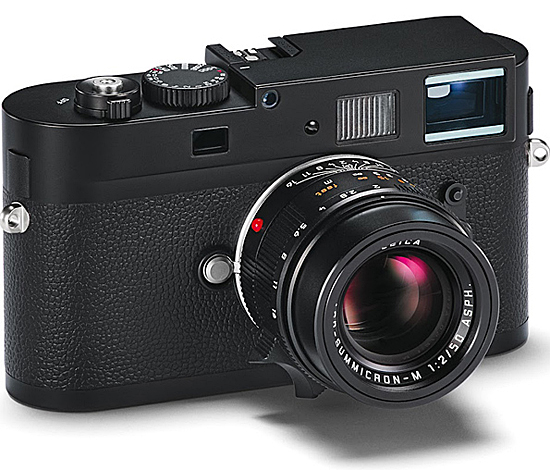
Leica M Monochrom Key Features:
- 18MP 23.9x35.8mm, 18MP Dedicated Black-And-White Sensor
- Center-weighted TTL metering
- ISO range 320-10,000, "pulled" to ISO 1600.
- Aperture-priority and Manual Exposure
- Hot shoe
- RAW (DNG), JPEG File Formats
- Viewfinder magnification: 0.68
- 2.5-inch LCD monitor with 230k pixel resolution
- Shutter speeds B, 8-1/4000 sec
- Noise reduction available
"$8,000 for a camera that only shoots black-and-white? Is Leica nuts?" I've heard this question about Leica M Monochrom ever since it was announced this fall, and have been curious and intrigued. One of the first evaluation units to reach the U.S. arrived in my hands in the winter of 2013 and I spent two weeks taking pictures in as many different situations as possible, in the hopes of answering the somewhat more diplomatically-posed question: "What benefit would a photographer get from spending so much money for a dedicated black-and-white camera, and is it worth it?"
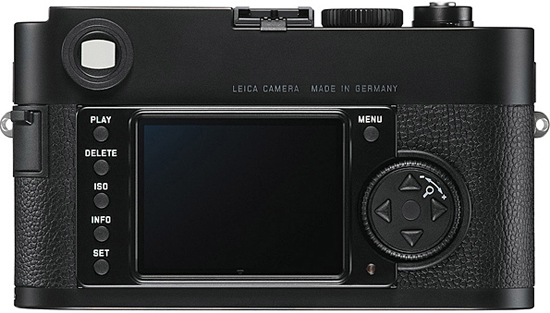
Here's the spoiler: The Leica M Monochrom delivered the best black-and-white image quality I've ever seen from a digital camera. With a $7,950 price tag, most mortals are bound to say "no, thanks" but for the elite few who can afford one and are willing to part with that kind of scratch, you're in for something special. Leica has always been in a category all its own, and this camera was, by its management's admission, built with no specific market in mind. They built it; now, who will buy it? After using and testing this camera for the past few weeks, I feel this camera may have a larger potential audience than people expect.
The Secret Sauce: All The Light Reaches The Sensor
First, let's talk about how almost all other digital cameras capture black-and-white, and compare that to the Leica M Monochrom. The typical digital camera sensor's pixels are divided into Red, Green and Blue filters. Light passes through the filters onto the sensor surface; The RGB data is gathered and assembled electronically into a color image. When choosing black-and-white in-camera, the camera discards a bunch of information, leaving only the black and white.(If you shot in RAW, the color information is still contained in the image file.)
But...thanks to the aforementioned RGB filters, some of the light never reaches the pixel, effectively reducing the sensor's light sensitivity.
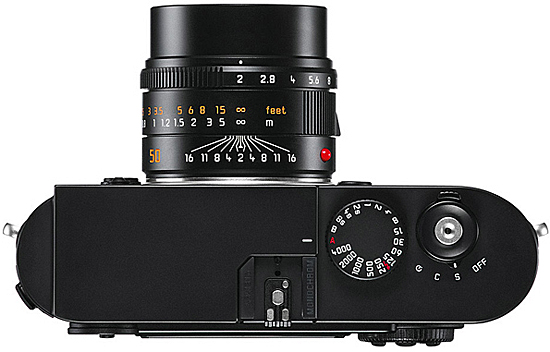
Here's where the Leica M Monochrom is brilliant.
The Leica M Monochrom has an 18MP sensor, but the RGB filters have been removed. All of the light that reaches the sensor is used, creating what Leica describes as a "purer" image. Without the light-blocking filters, the effective sensitivity of the sensor is boosted considerably. Since the sensors are no longer divided into RGB, the individual sensor sights are larger, resulting in less noise at high ISOs.
At least, that's what is supposed to happen.
The original Leica M9's full frame sensor fell short of expectations. I found image quality was outstanding at low speeds but started to deteriorate by ISO 800 when shooting in black-and-white, and grain became obvious by ISO 1600. But that was so 2009. Can the Leica M Monochrom, with its new sensor and no light-reducing filters, deliver the amazing quality Leica claims? I spent a couple of weeks using this remarkable camera doing street photography in New York City, as well as under more controlled circumstances. Here's what I found.
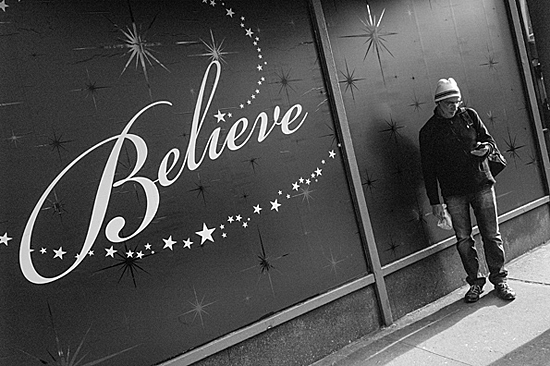
Looks pretty good, huh? Wouldja believe this was shot at ISO 6400? Believe it!

Here's a 100% enlargement from another shot, also done at 6400. I think this is kinda Tri-X like. What do you think?
Using The Monochrom: Get In Touch With Your Internal Carter-Bresson
The Leica M Monochrom's overall feel is virtually identical to that of the M9, and the control layout is elegantly simple. It is designed for experienced photographers who not only are able to handle automatic controls, but prefer them. There's no autofocus, and only Aperture-priority, center-weighted metered autoexposure. Manual shutter speed, aperture and focus settings are at your fingertips. Long-time Leica users already know this and appreciate the Leica M-series' unique approach to camera design. If you are new to Leica, you may want to read my review of the Leica M9 to learn more about that camera's controls and feel, which are virtually identical to the M Monochrom.
The rangefinder covers a full 28mm angle of view, with bright line indicators for longer focal length lenses. Focus is confirmed when overlapping images in a small rectangle merge. I found the rangefinder to be bright and easy to use, even with eyeglasses. The 2.5-inch, 230,000 pixel resolution LCD is the camera's weakest feature (as it was with the M9), with the relatively low resolution and dark display (even when adjusted) making it difficult to judge image quality in preview mode. I would like to see Leica upgrade its LCD monitor for a better chimping experience.
The Leica M runs on a similar Li-ion battery as its predecessors, and this battery drains quite fast. I recommend investing in at least one additional battery. With minimum chimping, I used up the battery after about 4 hours of heavy street shooting. Considering there are fewer causes for the battery to drain (no autofocus or image stabilization, for instance) the battery should last longer than it does, which seems to be in the 300-400 shot range, depending on how heavily you rely on the preview mode.
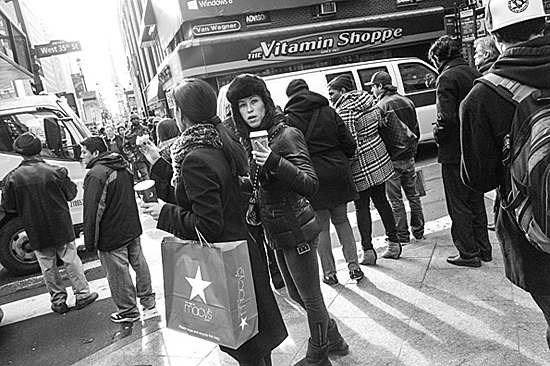 Incredible detail in the shadows: RAW images in tough lighting displayed a wide range from bright highlights to deep blacks that would have been lost in a lesser camera.
Incredible detail in the shadows: RAW images in tough lighting displayed a wide range from bright highlights to deep blacks that would have been lost in a lesser camera.
Image Quality To Die For, But Is It Worth Breaking The Bank?
To roughly determine image quality, I conducted field tests. Here's a summary.
While the JPEG files were excellent, the RAW files allowed for much greater control in post-processing and revealed much more detail in both shadows and highlights. While this may not be news to those who shoot RAW regularly, the flexibility gained by shooting RAW in a camera that is natively monochrome-only was a revelation. Shooting RAW comes with a price: The RAW images are huge, at 36MB uncompressed. But there is a lot of information in those images.
The Leica M Monochrom has a wide dynamic range and was unusually forgiving for a digital camera, a welcome attribute for a camera that is likely to be embraced by photojournalists and street photographers. But the real story here is the digital noise—or lack thereof—at higher than expected ISO settings.
When applying noise reduction, you can expect to gain a stop or two of low-noise images, which means shooting almost noise-free up to almost ISO 5000! Use any Leica lens, such as the Leica 28mm f/2.8 Elmarit-M, Leica 35mm f/1.4 Summilux-M, or Leica 50mm f/2 Summicron-M, and the combination of superior optics and high image quality—along with the camera's relatively compact size (compared to a top-line DSLR)—and you've got a winning, no-compromises combination.
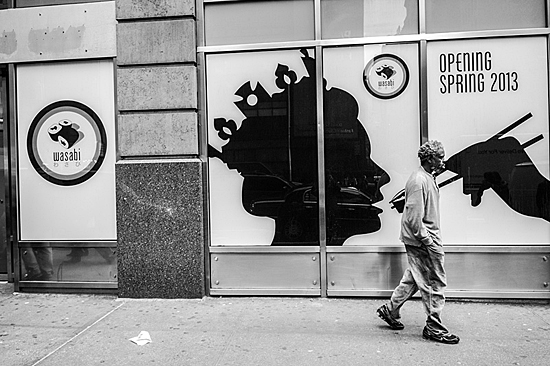
Fast-reacting: The Leica M Monochrom has no lag time, making it possible to keep up with fast-changing street scenes like this one where a small fraction of a second's hesitation means the difference between a successful photo and an oops-just-missed shot.
Street Photography With the Leica M Monochrom: Yeah, That's a Leica
It was no surprise that the Leica M Monochrom passed the Street Photo Stress Test with flying colors, reacting instantly with no lag time. The only exception was when I shot more than 5 or 6 images in rapid succession while shooting RAW+JPEG. Then the buffer would fill and I would have to wait before shooting again. While I think the camera's buffer performance has improved slightly over the M9's, there is still room for improvement.
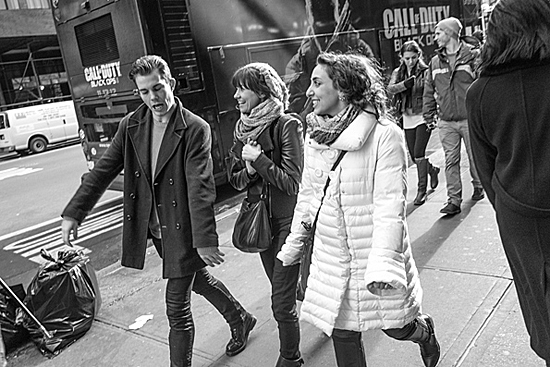

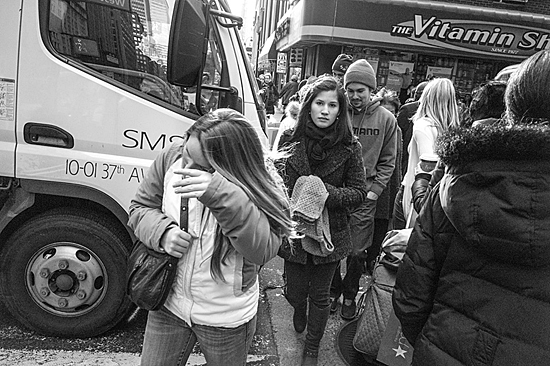
However, knowing its outstanding image quality performance at higher speeds, I cranked up the ISO and shot between ISO 1600 and ISO 4000, working in subdued mid- to late-December daylight and getting reasonable shutter speeds and mid-range aperture settings in the shade., using a Leica 28mm f/2.8 Elmarit-M lens as my optic. Bottom line: The Leica M Monochrom is a fantastic camera for black-and-white street photography.
Conclusion and Recommendation: Loan Officers are Standing By
So the big question is: "$8,000 for a camera that only shoots black and white—is Leica nuts?" The answer is: It depends on how badly you want a camera that delivers what is arguably the best black-and-white images in the world, and if you can afford it. (It could be argued that the Nikon D800E, at around $3,000, may be in the same image-quality ballpark, but alas, I can't make a direct comparison based on lab tests.)
Match the Leica M Monochrom with any Leica lens see list on left column) and you have a truly great camera that will deliver image quality without peer. But while its high-speed performance and along with its classical Leica features make it a camera of desire for street shooters and photojournalists, it also delivers remarkable low-speed image quality. In fact, this camera, a tripod and a set of color filters to control relative grays based on colors, may become a camera of choice for Ansel Adams-like landscape photography. It will deliver super-sharp large prints; shoot in RAW and you will get incredibly high dynamic range images.
For black-and-white enthusiasts, in my humble opinion, the Leica M Monochrom is now officially the holy grail of digital cameras. Yes, it's pricey. OK, very pricey. But you might eventually be able to get the thrill of using it brifely by renting it, when it becomes available. And for those who are willing and able to cough up $7,950 for the privelege of owning and using one, I have the following advice: Start saving!
What's your favorite digital camera for black-and-white photography?
Leave a comment!
My Street Photography Workshop with Garry Winogrand